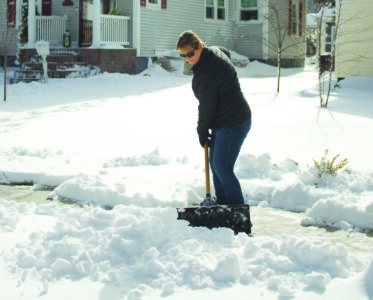Experts suggest fire as tool to manage red pines
ESCANABA — Fires are a valuable management tool when it comes to maintaining the health of red pine forests. The notion has been studied and accepted by modern scientists for decades, and evidence from as far back as 500 years ago shows that indigenous people used controlled burns, which clean the understory of competing vegetation and reduce pests like ticks and flying insects.
Not all types of tree are as hearty in the face of fire as red pine — Pinus resinosa.
“Red pine is very unique, at least in this region, in its ability to sort of heal over from fire. So it’ll scar, and then its trauma response is to pump resin through there,” said Jesse Lincoln, plant ecologist and conservation scientist for the Michigan Natural Features Inventory, when speaking to the Michigan Society of American Foresters recently.
The mission of the Michigan Natural Features Inventory, affiliated with Michigan State University Extension, is to “be the authoritative source of information on biodiversity that is widely used to conserve Michigan’s unique natural heritage for current and future generations.” Part of the reason they’re emphasizing red pines is because plantations are having little success in regeneration.
Many inland natural pine forests that have been thinned and scarified “lack diversity, (have) inadequate regen — especially not hitting any off the targets… fewer berry crops, and are less resistant to wildfire,” Lincoln shared.
Other management attempts, like treating with herbicide, can be harmful.
Back in 1935, the Journal of Forestry published an article entitled “Fire as a necessary factor in the perpetuation of white pine,” which was written by D. K. Maissurow, formerly a district forester of the Canada Power and Paper Corporation.
Maissurow’s study had begun when the paper company noticed that regrowth of white pine was very spotty in ares it had logged. In areas where pine forests were clear-cut, only 5% of the regrowth was pine. However, about 17% of burned areas repopulated with pine. The Canadian forester found that pine reproduction began shortly after the occurrence of fire and always following a seed year — pines produce good seed every three to five years, rather than every year.
Though white pine had been the prevalent species in the 1935 study — which focused on a 600-square-mile parcel in Pontiac County, Quebec — C. E. Van Wagner wrote a few decades later that “red pine, even more so than white pine, depends on fire for its existence in any quantity in the natural forest.”
When it comes to early growth and establishment of red pine, certain properties of the tree call for a certain environment.
“Red pine needs either a mineral seedbed or one lightly covered with duff, as well as fair freedom from brushy competition in the first few years. It is also rather intolerant of shade and does poorly under a full canopy. Fire is the only natural agent capable of providing all the required conditions,” wrote Van Wagner in “Fire and Red Pine,” published 1970.
Though those early studies continue to be referenced by 21st-century researchers, they also now have a greater selection of data and technology at their disposal.
Red pine stumps show evidence of fire scars — dark rings produced by burns and subsequent resin production — as mature trees healed and continued to grow.
“These (fire scars) are really interesting because they preserve the site’s unique fire history,” said Lincoln. “And so there are a lot of efforts across … the Great Lakes region to reconstruct fire histories using these red pine stumps.”
Often, red pine forests were maintained by regular burns every five to ten years, sometimes more frequently. In other places, some rings show that fire return intervals were every 40 to 70 years. The majority of burns took place in the late to dormant season.
Lincoln believes a good burn frequency target to aim for is 10 to 30 years.
He pointed out that a 2004 report published by the Michigan Department of Natural Resources on red pine discussed the importance of fire, but failed to mention Native American practices.
Tree rings and fire scars in not only the Great Lakes region but elsewhere in the country show that the pattern of regular burns dropped off after European colonization, which most believe clearly indicates that indigenous people were maintaining forest health through silviculture until white settlers interrupted their ways and relocated the native tribes from their homelands.
Clearing undergrowth by means of fire allows blueberry and huckleberry plants to thrive. Native Americans did it centuries ago, and today there remain some berry producers that regularly burn their fields by hand. In forests, fires reduce the numbers of ticks and other pests and may benefit game species.
During recent inventory taken of natural red pine stands over 100 years old, Lincoln said the lakeshore areas were the most interesting. Protected by dunes and hard to access with logging equipment, these areas had never been clearcut. Most of the trees in the lakeshore stands were 70 to 90 years old, but about 10% were older, about 170 to 220, with a few that were 300 years old.
“All the highest-quality examples had these burn scars on and showed evidence of frequent fire,” Lincoln said.
“Historically, recurrent fires were important in some locations, and the lack of fire over the last century is driving ecosystem changes that include the loss of open forest communities and pyrophilic species,” stated a 2022 article entitled “The North American tree-ring fire-scar network,” published by the The Ecological Society of America.
“In the absence of frequent surface fire, remaining red pine woodlands and forests will continue to be lost, and that’s to ongoing successional change, catastrophic fire, severe wind storms and potentially climate change-induced drought stress,” said Lincoln.
The suggested solution? Low- to moderate-severity fires, strong enough to kill pesky underbrush but not burn buttress roots or kill healthy trees. Boundaries should be well-defined, include wetlands and have burn lines cut in.
Since some forests haven’t had a burn in over 100 years, so Lincoln suggested reintroducing fire gently. Before harvesting, he said, “it would be two burns, five years apart, as low intensity, low severity as possible, just to condition the site for being burned again.”
He explained that even one- to five-year-old seedlings can survive mild fires, so he expects good results.
As for the hearty 200-year-old pines:
“So you protect these oldest trees. You protect your seed sources,” Lincoln prescribed. “These older trees have a lot of valuable genetic material for disease resistance. So — the greater the diversity, the greater it can withstand an uncertain future.”
Though some areas should be protected — Lincoln even identified some areas, like along river slopes, that should never be cut — he expects others to regenerate well after being thinned or clearcut sometime after those initial two fires.
He suggested “long harvest cycles” of perhaps 20 to 30 years and rotating which groups of trees to cut so that there continues to be a variety of ages of tree.
14 sites — 10 in the northern Lower Peninsula and four in the Upper Peninsula — have been identified for trials of the prescription.
“We want to burn between thinnings, keep that natural process going, keep that regeneration happening, and keep knocking back the mesophytic species that are taking over. And then, of course, long-term monitoring to evaluate the success of this approach,” Lincoln explained.
In summary of the reasoning:
“Pre-colonial dry forests in the Great Lakes historically had a diversity of spatial arrangements and contained a diversity of size, age and vertical height and canopy structures, and they were influenced by frequent, low intensity fire,” he concluded. “This heterogeneity suggests a starting place for silviculture prescriptions and management targets, particularly where objectives extend beyond production forestry.”


